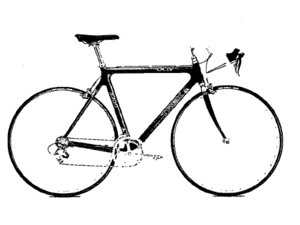Material use in bicycle frames
| Topics: |
What are the best materials to use in bicycle frames—steel? aluminum? carbon fiber? Magnesium? titanium? The answer lies in the physical properties of these materials—their characteristics and how they behave under certain conditions. The designer chooses the material that best suits the intended use of the bike (road or offroad), and the expected cost (titanium and carbon fiber are especially expensive). Listed below are some of the properties bike designers look at when they build a bicycle.
 Bike Frame (Source: Chemistry Explained)
Bike Frame (Source: Chemistry Explained) Density.—Density is how much a material weighs for a given volume. Titanium is about one-half the density of steel, and aluminum is about one-third the density of steel.
Stiffness.—The measurement for stiffness is called the modulus of elasticity; it is the degree to which a material that undergoes stress can deform, and then recover and return to its original shape after the stress ceases. The bigger the number, the stiffer the material. A steel bicycle tube is generally stiffer than a titanium or aluminum tube, although tube diameter and wall thickness also affect stiffness.
Elongation.—Elongation is a measure of how far a material will stretch before it breaks. It is very sensitive to the type of alloy used and how the metal is processed. The smaller the elongation number, which is expressed as a percentage, the more brittle the bicycle frame. Elongation numbers for titanium bicycle tubes are highest—from 20% to 30%; for steel tubes, from about 10% to 15%; and for aluminum, from 6% to 12%.
Tensile Strength.—Tensile strength is a measure of the greatest longitudinal stress a substance can bear without tearing apart; it is expressed as a ratio of maximum load to crosssectional area. The tensile strength of a bicycle tube varies with the type of alloy used and how the tube is made. The tensile strength of a typical titanium alloy bicycle tube ranges from approximately 700 to 910 megapascals (MPa); of a steel tube, from 630 to 1190 MPa; and of an aluminum tube, from 210 to 350 MPa.
Fatigue Strength.—Fatigue strength is a measure of the stress at which a material fails after a number of cycles. Steel and titanium alloys have a specific fatigue strength below which a load (force) may be applied an infinite number of times without causing the metal to bend or break. Aluminum alloys will, however, fail after enough load cycles even with a very small load. This is why aluminum tubes are generally much thicker than steel or titanium tubes.
Toughness.—Toughness is the ability of a metal to absorb energy and deform before fracturing (breaking). A tough metal is more ductile (pliable) and deforms rather than breaks. A very important requirement of bicycle tubes is their ability to flex. Toughness is, however, a complex property to measure and analyze.
For more information on the minerals used in manufacturing
bicycles, see the USGS minerals information Web site at
Further reading:
- Exploratorium.edu, Science of Cycling: Frames & Materials.
- Nicol, Scot, 1994. Metallurgy for cyclists I: The basics.
- USGS, 2006. Minerals Statistics and Information. U.S. Geological Survey.